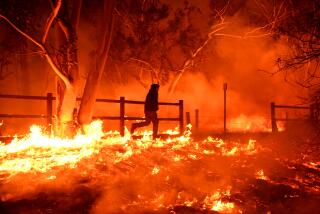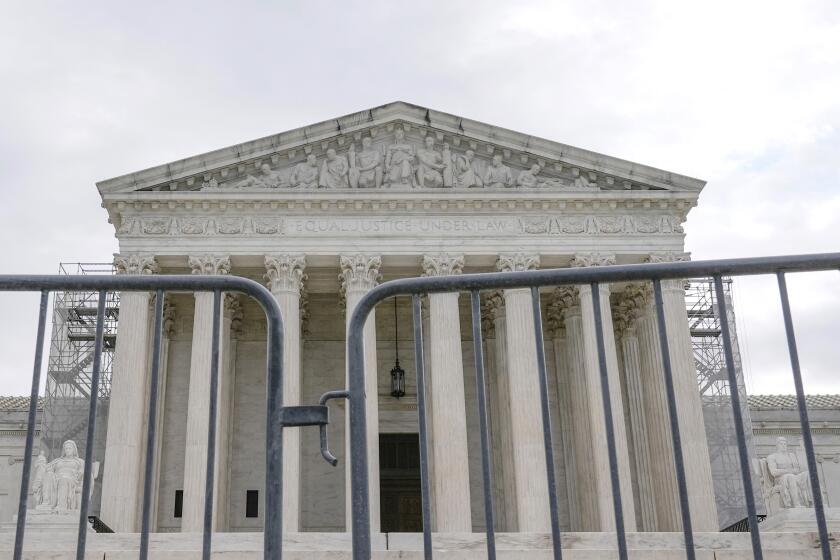California needs a big pot of money for wildfires. But how big? And who pays?

California leaders are calling for a giant pot of money to help electricity providers cover wildfire liabilities, a critical move to head off another utility bankruptcy and also to prevent Wall Street from hammering utility stock prices again.
But it could prove difficult to achieve in Sacramento this year.
For the record:
8:20 a.m. June 17, 2019An earlier version of this article said Gov. Newsom was expected to unveil a more concrete proposal for reducing wildfire costs as early as next week. He is expected to unveil it as early as this week.
With a deadline to take action just weeks away, lawmakers and the governor haven’t settled controversial issues regarding the so-called wildfire fund: How much money does the state need and what portion of that will come out of the pockets of electricity customers?
Lawmakers are looking to Gov. Gavin Newsom to take the lead and provide answers to one of California’s most high-stakes problems. His response could define his early administration.
“The decisions have got to be made,” said Assemblyman Chad Mayes (R-Yucca Valley). “At this point, we’re just waiting to see what the executive’s office comes up with and how we’re going to move forward.”
Newsom inherited the wildfire quandary from previous administrations, just as former Gov. Gray Davis took office with a deregulated power market before the 2000 energy crisis.
The problem has been complicated by climate change, forest management, outdated and neglected electrical infrastructure and local land-use decisions that allow communities to sprawl deeper into fire-prone areas.
Stock analysts predict that Southern California Edison could follow Pacific Gas & Electric into bankruptcy if Newsom fails to calm the energy markets and a major wildfire hits in Southern California, leaving victims across the state struggling to recoup their losses from insolvent utilities.
S&P Global Ratings is threatening to downgrade Southern California Edison and San Diego Gas & Electric if the Legislature misses a July 12 deadline Newsom set to pass a bill. Other agencies have issued similar threats to downgrade the utilities.
But ratepayer advocates fear that legislative efforts to prop up the companies will leave utility customers picking up the tab.
A wildfire commission created by the state Legislature suggested two models for funds to help reduce wildfire liability risk, although details of how they would work remain under debate.
The governor’s office favors an idea, referred to as a “liquidity fund,” that would require at least $10 billion. In April, the administration proposed continuing a state Department of Water Resources charge on ratepayers that was implemented during the last energy crisis to provide the funding. The charge, which adds a few dollars to monthly electricity bills, is set to sunset in 2020.
The money could be lent to investor-owned utilities to pay off victims after a wildfire. The companies could be expected to return the money to the fund after the California Public Utilities Commission determines who should pay damages from the blaze.
“The goal of a liquidity fund is to prevent investor panic from getting out of control and leading to a bankruptcy,” Michael Wara, director of Stanford University’s climate and energy policy program, told state senators last week.
The governor’s office late last month said that it would also seek changes to the state’s standards for utilities to prevent wildfires, which might shift more financial burden to ratepayers.
But a liquidity fund poses significant risk. If a utility declared bankruptcy after receiving a loan from the fund, the ratepayer money might not be fully repaid.
Mark Toney, executive director of the Utility Reform Network, a ratepayer advocacy group, supports the idea of continuing the Department of Water Resources charge and said the state should use the money for wildfire prevention. He sharply criticized the liquidity fund as a “slush fund” for the utilities.
“To me, there’s too much focus on who’s going to pay for the damage for future wildfires and not enough on how the hell we are going to prevent utilities from starting them in the first place,” Toney said.
A second fund model, sometimes referred to as a wildfire victims fund, would require $40 billion by some estimates and serve as a second insurance policy for the utilities over the next decade.
The goal is to have a pot of money large enough to protect ratepayers from additional bill increases, provide stability to the financial markets and make utilities less likely to file for bankruptcy. Utilities, ratepayers, property owners and taxpayers could be required to pay into the fund, according to the wildfire commission.
Policy analysts say it would be difficult to secure billions of dollars from the utilities, including PG&E, in the midst of a federal bankruptcy case. But if utilities provide significant funding, it’s possible that lawmakers would cap the amount of money utilities would have to ultimately pay in liability.
In a test of his ability to steer the state away from crisis, the governor convened a team this year to map out a solution. Newsom hired O’Melveny & Myers, a Los Angeles law firm, and Guggenheim Securities, a New York financial services advisory firm, to help his top advisors, at a cost of $6 million over six months.
The governor in February promised to deliver a “comprehensive strategy” to address the wildfire cost problem in April. Instead, his office issued a report outlining suggestions for lawmakers.
Newsom is expected to unveil a more concrete proposal as early as this week.
At a news conference this month, he questioned whether the state could hit his July 12 deadline to pass legislation and solve the “challenging” issue.
“This is a lot of moving pieces,” Newsom told reporters. “This is a tough issue. Look, if it’s not July 12, it’s not July 12. But we have to do something quickly.”
If the Legislature fails to pass legislation to significantly reduce the utility industry’s risk for wildfires, the credit downgrades from the ratings agencies could lead to higher borrowing costs for the utilities and monthly bills for electricity customers.
“They do not see a sustainable business model in the utility space in California because of what they see as unlimited downside risk,” Wara said. “We need to change that perception at the minimum cost to ratepayers and to victims.”
A legal doctrine called inverse condemnation holds utilities responsible for property damages from wildfires linked to their equipment. The system generally worked until a wildfire exceeded a California utility’s insurance coverage for the first time in 2007.
San Diego Gas and Electric asked the CPUC to allow it to recover $379 million, wildfire costs in excess of the company’s insurance policy, from ratepayers for a trio of deadly blazes. In a landmark 2017 ruling, the CPUC determined that the company failed to prudently manage and operate its system and denied the request, which created mass uncertainty in the electricity market.
In an era of increasingly destructive wildfires, utilities, stock analysts, investors and ratings agencies have argued that California electrical utilities are vulnerable to unpredictable financial liability.
The state’s two largest electrical utilities, PG&E and Edison, lobbied the Legislature for changes in 2018. A law approved last year allowed the utilities to shift some wildfire costs onto ratepayers, but Wall Street criticized it for not going far enough.
Less than one month after the law took effect, PG&E filed for bankruptcy, citing some $30 billion in potential debt from wildfire damage.
“It’s going to be another big-ticket item that we’re going to have to get into in the coming weeks,” said Senate Pro Tem Toni Atkins after the Legislature approved the state budget last week. “We’re going to get very serious about this discussion. Obviously, it’s something we’re all very concerned about.”
More stories from Taryn Luna »
Follow @tarynluna on Twitter.
More to Read
Get the L.A. Times Politics newsletter
Deeply reported insights into legislation, politics and policy from Sacramento, Washington and beyond. In your inbox three times per week.
You may occasionally receive promotional content from the Los Angeles Times.







